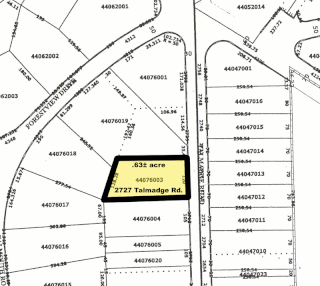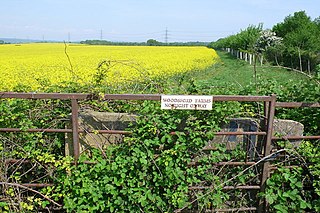Related Research Articles

In the United States, a conservation easement is a power invested in a qualified private land conservation organization or government to constrain, as to a specified land area, the exercise of rights otherwise held by a landowner so as to achieve certain conservation purposes. It is an interest in real property established by agreement between a landowner and land trust or unit of government. The conservation easement "runs with the land", meaning it is applicable to both present and future owners of the land. The grant of conservation easement, as with any real property interest, is part of the chain of title for the property and is normally recorded in local land records.
This aims to be a complete list of the articles on real estate.
An estate in land is, in the law of England and Wales, an interest in real property that is or may become possessory. It is a type of personal property and encompasses land ownership, rental and other arrangements that give people the right to use land. This is distinct from sovereignty over the land, which includes the right to government and taxation.

In the United States, a plat (plan) is a cadastral map, drawn to scale, showing the divisions of a piece of land. United States General Land Office surveyors drafted township plats of Public Lands Surveys to show the distance and bearing between section corners, sometimes including topographic or vegetation information. City, town or village plats show subdivisions broken into blocks with streets and alleys. Further refinement often splits blocks into individual lots, usually for the purpose of selling the described lots; this has become known as subdivision.
A profit, in the law of real property, is a nonpossessory interest in land similar to the better-known easement, which gives the holder the right to take natural resources such as petroleum, minerals, timber, and wild game from the land of another. Indeed, because of the necessity of allowing access to the land so that resources may be gathered, every profit contains an implied easement for the owner of the profit to enter the other party's land for the purpose of collecting the resources permitted by the profit.
An equitable servitude is a term used in the law of real property to describe a nonpossessory interest in land that operates much like a covenant running with the land. In England and Wales the term is defunct and in Scotland it has very long been a sub-type of the Scottish legal version of servitudes, which are what English law calls easements. However covenants and equitable servitudes in most of the jurisdictions across North America, are slightly different. The usual distinction is based on the remedy plaintiff seeks and precedent will allow for the scenario in question. Where the terms are unmerged, holders of a covenant seek money damages; holders of equitable servitudes seek injunctions. The term used to exist in England widely before Tulk v Moxhay and as byproduct of the Judicature Acts became one of the fullest mergers of equity and common law in England and Wales so as to agree initially on the term "equitable covenant", then coming to be united in the term covenant save that "equitable" bears a particular meaning in English property rights since at least 1925: it means not fully compliant with registration/written formalities. If lacks legally routine formalities it is not a full legal covenant and therefore more tenuous, often only enforceable personally and against the original covenantor.
A servitude is a qualified beneficial interest severed or fragmented from the ownership of an inferior property and attached to a superior property or to some person other than the owner. At civil law, ownership (dominium) is the only full real right whereas a servitude is a subordinate real right on par with wayleaves, real burdens, security interests, and reservations. There are two types: predial, attaching to property, and personal, attaching to a person.
In real estate, a lot or plot is a tract or parcel of land owned or meant to be owned by some owner(s). A plot is essentially considered a parcel of real property in some countries or immovable property in other countries. Possible owner(s) of a plot can be one or more person(s) or another legal entity, such as a company/corporation, organization, government, or trust. A common form of ownership of a plot is called fee simple in some countries.
A common area is, in real estate or real property law, the "area which is available for use by more than one person..." The common areas are those that are available for common use by all tenants, (or) groups of tenants and their invitees. In Texas and other parts of the United States, it is "An area inside a housing development owned by all residents or by an overall management structure which charges each tenant for maintenance and upkeep."

Re Ellenborough Park[1955] EWCA Civ 4 was an English land law case which reformulated the tests for an easement. It found an easement to use a communal garden to be a valid easement in law. There is no requirement for all of the houses to be immediately next to the garden to benefit from it.
Robert Francis Brachtenbach was an American politician and jurist from the state of Washington.
An easement is a nonpossessory right to use and/or enter onto the real property of another without possessing it. It is "best typified in the right of way which one landowner, A, may enjoy over the land of another, B". An easement is a property right and type of incorporeal property in itself at common law in most jurisdictions.
A solar easement is a right, expressed as an easement, restriction, covenant, or condition contained in any deed, contract, or other written instrument executed by or on behalf of any landowner for the purpose of assuring adequate access to direct sunlight for solar energy systems.
A servient estate is a parcel of land that is subject to an easement. The easement may be an easement in gross, an easement that benefits an individual or other entity, or it may be an easement appurtenant, an easement that benefits another parcel of land.
Moncrieff v Jamieson [2007] UKHL 42 is a Scottish property law case decided by the House of Lords on servitudes.

M.P.M. Builders, LLC v. Dwyer, 442 Mass. 87, 809 N.E.2d 1053 (2004), was a case decided by the Massachusetts Supreme Court that first adopted the Restatement Third of Servitudes for the relocation of easements in that state.
Easements in English law are certain rights in English land law that a person has over another's land. Rights recognised as easements range from very widespread forms of rights of way, most rights to use service conduits such as telecommunications cables, power supply lines, supply pipes and drains, rights to use communal gardens and rights of light to more strained and novel forms. All types are subject to general rules and constraints. As one of the formalities in English law express, express legal easements must be created by deed.

Right of way is the legal right, established by grant from a landowner or long usage, to pass along a specific route through property belonging to another. A similar right of access also exists on land held by a government, lands that are typically called public land, state land, or Crown land. When one person owns a piece of land that is bordered on all sides by lands owned by others, an easement may exist or might be created so as to initiate a right of way through the bordering land.

South African property law regulates the "rights of people in or over certain objects or things." It is concerned, in other words, with a person's ability to undertake certain actions with certain kinds of objects in accordance with South African law. Among the formal functions of South African property law is the harmonisation of individual interests in property, the guarantee and protection of individual rights with respect to property, and the control of proprietary relationships between persons, as well as their rights and obligations. The protective clause for property rights in the Constitution of South Africa stipulates those proprietary relationships which qualify for constitutional protection. The most important social function of property law in South Africa is to manage the competing interests of those who acquire property rights and interests. In recent times, restrictions on the use of and trade in private property have been on the rise.

London and Blenheim Estates Ltd v Ladbroke Retail Parks Ltd [1993] 4 All ER 157 is an English land law case, concerning easements. It persuasively confirmed for one of the first times, obiter, that parking a car on land on its own could be the appropriate subject matter for an express easement. It established that an arrangement for a future extension of easement rights over specific other land would require a specific parcel of dominant land too. Simply agreeing that wherever any dominant land is extended the easement on the servient land will be extended is insufficient.
References
- ↑ Law Dictionary
- ↑ "CODE OF IOWA TITLE XIV. PROPERTY SUBTITLE 2. REAL PROPERTY -- GIFTS CHAPTER 564A. ACCESS TO SOLAR ENERGY IOWA CODE § 564A.1 (2003)". dsireusa.org. Database of State Incentives for Renewables and Efficiency. Archived from the original on 27 September 2007. Retrieved 24 March 2014.
- ↑ Canadian law article on dominant estate Archived November 26, 2003, at the Wayback Machine
- ↑ Hawaii Archived May 14, 2007, at the Wayback Machine
- ↑ Iowa Archived September 27, 2007, at the Wayback Machine
- ↑ "N.C. Administrative Office of the Courts". aoc.state.nc.us. 1998. Archived from the original on 27 March 2014. Retrieved 24 March 2014.
- ↑ South Carolina
- ↑ Virginia
- ↑ Arizona law Archived June 14, 2007, at the Wayback Machine
- ↑ Texas law Archived August 21, 2008, at the Wayback Machine